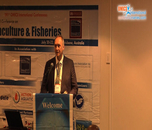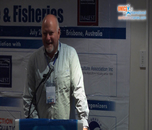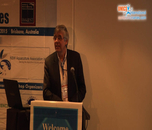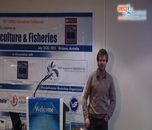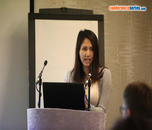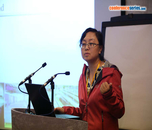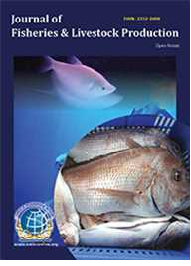Theme: Recent Advances in Aquaculture & Fisheries
Aqua Europe 2017
ConferenceSeries Ltd invites all the participants from all over the world to attend ‘5th Euro Global Summit on Aquaculture & Fisheries (Aqua Europe 2017) during March 30-31, 2017 at Madrid, Spain which includes prompt Keynote, Oral and Poster presentations and Exhibitions.
ConferenceSeries Ltd organizes a of 3000+ Global Events inclusive of 600+ Conferences, 1200+ Upcoming and Previous Symposiums and 1200 Workshops in USA, Europe & Asia with support from 1000 more scientific societies and publishes 700+ Open access journals which contains over 50000 eminent personalities, reputed scientists as editorial board members.
Why to attend?
Ø Learning, understanding and knowledge about fisheries are developed in participation with others.
Ø To make a bridge between academic & business, government & non-governmental organizations concerned in such activities
Ø Promote new products and ideas and increase general awareness.
Ø An important forum for the presentation of new advances, research findings and the newest technologies in the fields of Aquaculture and Fisheries whether it is theoretical, experimental or applied.
Aqua Europe 2017 will bring together leading aquaculture professionals, researchers and scientists, business delegates, industry professionals from around the world to discuss new findings and current issues pertaining to Aquaculture and Fisheries.
Looking forward to see you at Madrid, Spain.
Track 1:- Aquatic Ecosystem and Aqua Farming Method
An ecosystem is the complete set of living and nonliving components within a region of interest. The term aquatic refers to water, so an aquatic ecosystem refers to living and nonliving parts of a waterbody and the interactions that take place among them. Aquatic ecosystems include oceans, lakes, rivers, streams, estuaries, and wetlands. Within these aquatic ecosystems are living things that depend on the water for survival, such as fish, plants, and microorganisms. These ecosystems are very fragile and can be easily disturbed by pollution. Aqua farming may take place in the ocean or on land, and can be used to grow marine or freshwater species. The environmental impact of farmed seafood is to a great extent determined by the farming method used.
Related: Aquaculture Conferences | Fishery Conferences | Aquaculture and Fishery Meetings | Aqua Congress | European Aquaculture Conferences | European Fishery Conferences | ConferenceSeries Ltd
5th Euro Global Summit on Aquaculture & Fisheries March 30- April 1, 2017,Madrid, Spain; 7th International Conference on Aquaculture & Fisheries, October 19-21, 2017 Rome, Italy; 8th International conference on Fisheries & Aquaculture, October 02-04, 2017 Toronto, Canada; 4th Annual International Conference on Fisheries and Aquaculture 2017, August 24-25, 2017, Colombo, Sri Lanka; World Aquaculture 2017, June 26-30, 2017, Cape Town, South Africa; International Conference on Marine Science & Aquaculture 2017, Mar 14-15, 2017, Sabah, Malaysia; 6th Global Summit on Aquaculture & Fisheries May 25-26, 2017 Osaka, Japan; 4th International conference on fish telemetry, June 19-23, 2017, Cairns, Australia; 19th International Conference on Fisheries and Aquaculture, January 26 - 27, 2017, Innsbruck, Austria; The 3rd Fisheries and Aquaculture Conference, May 18-20, 2017, Hangzhou, China; 19th International Conference on Fisheries, Aquaculture Economics and Seafood Trade, March 23 - 24, 2017, Prague, Czech Republic; The 8th World Recreational Fishing Conference, July 16 – 20, 2017, British Columbia, Canada.
Related Societies:
US Aquaculture Society, USA; World Aquaculture Society, USA; Coastal Aquaculture Society of India, India; Asian Fisheries Society, Singapore; Singapore Aquarium Fish Exporters Association, Singapore; Philippine, Philippines; Japan Fisheries Association, Japan; China Aquatic Products Processing and Marketing Alliance, China; National Aquaculture Association, USA; Korea Overseas Fisheries Association, Korea.
Track 2:- Targets and tools for selective Breeding of Aquaculture Species
Selective breeding has a very high potential for improving the genetic makeup of fish in aquaculture production. It just takes a few generations to accomplish major improvements in economically important traits. Selective breeding is the process where the genetic variation present in desirable traits within a population is used to improve production quality, efficiency and sustainability. A good example of the possible benefits of selective breeding is the selection for growth in fish. The genetic improvements that have been obtained for growth in aquaculture species are in general three to five times higher per generation than what is found for terrestrial livestock species in general. The benefits of the breeding scheme come through the additional and cumulative improvement of genetics of the offspring that enter the production system.
Related: Aquaculture Conferences | Fishery Conferences | Aquaculture and Fishery Meetings | Aqua Congress | European Aquaculture Conferences | European Fishery Conferences | ConferenceSeries Ltd
5th Euro Global Summit on Aquaculture & Fisheries March 30- April 1, 2017,Madrid, Spain; 7th International Conference on Aquaculture & Fisheries, October 19-21, 2017 Rome, Italy; 8th International conference on Fisheries & Aquaculture, October 02-04, 2017 Toronto, Canada; 4th Annual International Conference on Fisheries and Aquaculture 2017, August 24-25, 2017, Colombo, Sri Lanka; World Aquaculture 2017, June 26-30, 2017, Cape Town, South Africa; International Conference on Marine Science & Aquaculture 2017, Mar 14-15, 2017, Sabah, Malaysia; 6th Global Summit on Aquaculture & Fisheries May 25-26, 2017 Osaka, Japan; 4th International conference on fish telemetry, June 19-23, 2017, Cairns, Australia; 19th International Conference on Fisheries and Aquaculture, January 26 - 27, 2017, Innsbruck, Austria; The 3rd Fisheries and Aquaculture Conference, May 18-20, 2017, Hangzhou, China; 19th International Conference on Fisheries, Aquaculture Economics and Seafood Trade, March 23 - 24, 2017, Prague, Czech Republic; The 8th World Recreational Fishing Conference, July 16 – 20, 2017, British Columbia, Canada.
Related Societies:
Philippine Tropical Fish Exporters Association, Philippines; Japan Fisheries Association, Japan; China Aquatic Products Processing and Marketing Alliance, China; National Aquaculture Association, USA; US Aquaculture Society, USA; Korea Overseas Fisheries Association, Korea; National Aquaculture Development Authority of Sri Lanka, Sri Lanka; Korea Overseas Fisheries Association, Korea; Singapore Aquarium Fish Exporters Association, Singapore; China Aquatic Products Processing and Marketing Alliance, China.
Track 3:-Biosecurity in Aquaculture
Aquatic animal species are in constant interaction with potential pathogens that can strongly impair growth performance and result in significant economic losses for livestock production. Biosecurity encompasses all measures designed to prevent diseases from occurring and from spreading by isolating, as much as possible, animal farm populations from external contamination. Recurring or prolonged contact with external environments (water, sediment, wildlife) favours the development of new diseases. For this reason, non-recirculated aquaculture systems are more difficult to isolate than closed water circuits. Major Biosecurity goals are:
â– Animal management—obtaining healthy stocks and optimizing their health and immunity through good husbandry
â– Pathogen management—preventing, reducing or eliminating pathogens
â– people management—educating and managing staff and visitors.The ease with which a specific pathogen can enter a facility, spread from one system to another, and cause disease depends on the species, immune status, condition, life stage, and strain susceptibility of the cultured fish;
â– Major environmental factors such as water quality, water chemistry, and husbandry practices;
â– characteristics of the pathogen, such as biology and life cycle, potential reservoirs, survival on inanimate objects, options for legal treatment, regulatory status (exotic vs. endemic disease, report ability, and federal, state and local laws); and Workers’ understanding of biosecurity principles and compliance with biosecurity protocols.
Related: Aquaculture Conferences | Fishery Conferences | Aquaculture and Fishery Meetings | Aqua Congress | European Aquaculture Conferences | European Fishery Conferences | ConferenceSeries Ltd
5th Euro Global Summit on Aquaculture & Fisheries March 30- April 1, 2017,Madrid, Spain; 7th International Conference on Aquaculture & Fisheries, October 19-21, 2017 Rome, Italy; 8th International conference on Fisheries & Aquaculture, October 02-04, 2017 Toronto, Canada; 4th Annual International Conference on Fisheries and Aquaculture 2017, August 24-25, 2017, Colombo, Sri Lanka; World Aquaculture 2017, June 26-30, 2017, Cape Town, South Africa; International Conference on Marine Science & Aquaculture 2017, Mar 14-15, 2017, Sabah, Malaysia; 6th Global Summit on Aquaculture & Fisheries May 25-26, 2017 Osaka, Japan; 4th International conference on fish telemetry, June 19-23, 2017, Cairns, Australia; 19th International Conference on Fisheries and Aquaculture, January 26 - 27, 2017, Innsbruck, Austria; The 3rd Fisheries and Aquaculture Conference, May 18-20, 2017, Hangzhou, China; 19th International Conference on Fisheries, Aquaculture Economics and Seafood Trade, March 23 - 24, 2017, Prague, Czech Republic; The 8th World Recreational Fishing Conference, July 16 – 20, 2017, British Columbia, Canada.
Related Societies:
Society of Aquaculture Professional, India; Rajiv Gandhi Centre for Aquaculture (RGCA), India; Institute of aquaculture Singapore, Singapore; National Aquaculture Association, USA; World Aquaculture Society, USA; Coastal Aquaculture Society of India, India; Asian Fisheries Society, Singapore; Singapore Aquarium Fish Exporters Association, Singapore; Philippine Tropical Fish Exporters Association, Philippines
Track 4:- Aquaculture Waste Management
The growth in aquaculture has led to an increase in the use of feeds applied to water for improved production. The wastes that result from the use of aquaculture feeds are very much harmful for aquaculture. The management of aquaculture wastes has become a topic of intense regulatory scrutiny, as the Environmental Protection agency develops new waste management regulations for the entire industry.
Related: Aquaculture Conferences | Fishery Conferences | Aquaculture and Fishery Meetings | Aqua Congress | European Aquaculture Conferences | European Fishery Conferences | ConferenceSeries Ltd
5th Euro Global Summit on Aquaculture & Fisheries March 30- April 1, 2017,Madrid, Spain; 7th International Conference on Aquaculture & Fisheries, October 19-21, 2017 Rome, Italy; 8th International conference on Fisheries & Aquaculture, October 02-04, 2017 Toronto, Canada; 4th Annual International Conference on Fisheries and Aquaculture 2017, August 24-25, 2017, Colombo, Sri Lanka; World Aquaculture 2017, June 26-30, 2017, Cape Town, South Africa; International Conference on Marine Science & Aquaculture 2017, Mar 14-15, 2017, Sabah, Malaysia; 6th Global Summit on Aquaculture & Fisheries May 25-26, 2017 Osaka, Japan; 4th International conference on fish telemetry, June 19-23, 2017, Cairns, Australia; 19th International Conference on Fisheries and Aquaculture, January 26 - 27, 2017, Innsbruck, Austria; The 3rd Fisheries and Aquaculture Conference, May 18-20, 2017, Hangzhou, China; 19th International Conference on Fisheries, Aquaculture Economics and Seafood Trade, March 23 - 24, 2017, Prague, Czech Republic; The 8th World Recreational Fishing Conference, July 16 – 20, 2017, British Columbia, Canada.
Related Societies:
American Fisheries Society, USA; European Aquaculture Society, Belgium; National Aquaculture Association, Florida, USA; Australian Marine Conservation Society, Australia; Saudi Aquaculture Society, Saudi Arabia; US Aquaculture Society, Asian Fisheries Society, Malaysia; Michigan Aquaculture Association, USA; Aquaculture association of Canada, Canada; World Aquaculture Society, USA;
Track 5:- Climate Effects on Fish Physiology and Growth
The difference between maximum metabolic rate and standard metabolic rate is referred to as aerobic scope, and because it constrains performance it is suggested to constitute a key limiting process prescribing how fish may cope with or adapt to climate warming. Owing to climate change, water temperatures have increased in marine and freshwater habitats around the world. Current projections predict a mean rise in temperature of 2–4°C globally by the end of this century, although locally the increase can be higher. For aquatic ectotherms, this may pose challenges of sufficient oxygen uptake to sustain their metabolic demand. The high thermal conductivity of water makes it challenging for aquatic ectotherms to maintain an internal temperature that differs from the surrounding water.
Related: Aquaculture Conferences | Fishery Conferences | Aquaculture and Fishery Meetings | Aqua Congress | European Aquaculture Conferences | European Fishery Conferences | ConferenceSeries Ltd
5th Euro Global Summit on Aquaculture & Fisheries March 30- April 1, 2017,Madrid, Spain; 7th International Conference on Aquaculture & Fisheries, October 19-21, 2017 Rome, Italy; 8th International conference on Fisheries & Aquaculture, October 02-04, 2017 Toronto, Canada; 4th Annual International Conference on Fisheries and Aquaculture 2017, August 24-25, 2017, Colombo, Sri Lanka; World Aquaculture 2017, June 26-30, 2017, Cape Town, South Africa; International Conference on Marine Science & Aquaculture 2017, Mar 14-15, 2017, Sabah, Malaysia; 6th Global Summit on Aquaculture & Fisheries May 25-26, 2017 Osaka, Japan; 4th International conference on fish telemetry, June 19-23, 2017, Cairns, Australia; 19th International Conference on Fisheries and Aquaculture, January 26 - 27, 2017, Innsbruck, Austria; The 3rd Fisheries and Aquaculture Conference, May 18-20, 2017, Hangzhou, China; 19th International Conference on Fisheries, Aquaculture Economics and Seafood Trade, March 23 - 24, 2017, Prague, Czech Republic; The 8th World Recreational Fishing Conference, July 16 – 20, 2017, British Columbia, Canada.
Related Societies:
American Fisheries Society, USA; European Aquaculture Society, Belgium; National Aquaculture Association, Florida, USA; Australian Marine Conservation Society, Australia; Saudi Aquaculture Society, Saudi Arabia; US Aquaculture Society, Asian Fisheries Society, Malaysia; Michigan Aquaculture Association, USA; Aquaculture association of Canada, Canada; World Aquaculture Society, USA
Track 6:-Aquaculture Disease, Diagnostic and Health Management
Fish diseases affect the survival and growth rates of fìsh under culture. Given that drug treatments are expensive, fìsh diseases invariably lead to lower harvest and higher cost. Fish farmers often suffer hefty economic losses due to fìsh diseases. To alleviate such losses, it is crucial to take precautions to prevent fìsh diseases and reduce pathogen levels in water bodies. It is also important to prevent water quality from deteriorating and to strengthen the natural resistance of the fìsh stock. Regular monitoring of fìsh health is an effective way to identify disease uses and appropriate treatments. One major cause of serious fìsh kill is overlooking the contagiousness of fìsh diseases and thus delaying treatment. As such, adequate care and treatment should be given to infected fish promptly.
Related: Aquaculture Conferences | Fishery Conferences | Aquaculture and Fishery Meetings | Aqua Congress | European Aquaculture Conferences | European Fishery Conferences | ConferenceSeries Ltd
5th Euro Global Summit on Aquaculture & Fisheries March 30- April 1, 2017,Madrid, Spain; 7th International Conference on Aquaculture & Fisheries, October 19-21, 2017 Rome, Italy; 8th International conference on Fisheries & Aquaculture, October 02-04, 2017 Toronto, Canada; 4th Annual International Conference on Fisheries and Aquaculture 2017, August 24-25, 2017, Colombo, Sri Lanka; World Aquaculture 2017, June 26-30, 2017, Cape Town, South Africa; International Conference on Marine Science & Aquaculture 2017, Mar 14-15, 2017, Sabah, Malaysia; 6th Global Summit on Aquaculture & Fisheries May 25-26, 2017 Osaka, Japan; 4th International conference on fish telemetry, June 19-23, 2017, Cairns, Australia; 19th International Conference on Fisheries and Aquaculture, January 26 - 27, 2017, Innsbruck, Austria; The 3rd Fisheries and Aquaculture Conference, May 18-20, 2017, Hangzhou, China; 19th International Conference on Fisheries, Aquaculture Economics and Seafood Trade, March 23 - 24, 2017, Prague, Czech Republic; The 8th World Recreational Fishing Conference, July 16 – 20, 2017, British Columbia, Canada.
Related Societies:
American Fisheries Society, USA; European Aquaculture Society, Belgium; National Aquaculture Association, Florida, USA; Australian Marine Conservation Society, Australia; Saudi Aquaculture Society, Saudi Arabia; US Aquaculture Society, Asian Fisheries Society, Malaysia; Michigan Aquaculture Association, USA; Aquaculture association of Canada, Canada; World Aquaculture Society, USA
Track 7:- Aquaculture Business Law, ethics and Policy
Aquaculture is normally included basically in the Fishery Sector Development Policy, document. It is also mentioned in other strategic policy documents; those for Industry and Environment are the two major policy documents concerned. In the absence of specific policy, aquaculture development is mainly based on development plans elaborated by the authorities in charge for the administering the sector but without formal approval. Participatory mechanisms concerned with the definition of policy mostly comprise unofficial consultations, with three exceptions. The first is in Spain where a formal Consultative Committee on Fisheries and Aquaculture has been established in Cataluña which includes representatives from the aquaculture sector. The second exception is Greece, where there is an Agricultural Policy Council (APC) operating within the Ministry of Agriculture; this is a consultative body within which representatives from the Ministry itself, scientific organisations, producers, and universities participate. The third exception is France, where there are "inter-professional committees.
Related: Aquaculture Conferences | Fishery Conferences | Aquaculture and Fishery Meetings | Aqua Congress | European Aquaculture Conferences | European Fishery Conferences | ConferenceSeries Ltd
5th Euro Global Summit on Aquaculture & Fisheries March 30- April 1, 2017,Madrid, Spain; 7th International Conference on Aquaculture & Fisheries, October 19-21, 2017 Rome, Italy; 8th International conference on Fisheries & Aquaculture, October 02-04, 2017 Toronto, Canada; 4th Annual International Conference on Fisheries and Aquaculture 2017, August 24-25, 2017, Colombo, Sri Lanka; World Aquaculture 2017, June 26-30, 2017, Cape Town, South Africa; International Conference on Marine Science & Aquaculture 2017, Mar 14-15, 2017, Sabah, Malaysia; 6th Global Summit on Aquaculture & Fisheries May 25-26, 2017 Osaka, Japan; 4th International conference on fish telemetry, June 19-23, 2017, Cairns, Australia; 19th International Conference on Fisheries and Aquaculture, January 26 - 27, 2017, Innsbruck, Austria; The 3rd Fisheries and Aquaculture Conference, May 18-20, 2017, Hangzhou, China; 19th International Conference on Fisheries, Aquaculture Economics and Seafood Trade, March 23 - 24, 2017, Prague, Czech Republic; The 8th World Recreational Fishing Conference, July 16 – 20, 2017, British Columbia, Canada.
Related Societies:
American Fisheries Society, USA; European Aquaculture Society, Belgium; National Aquaculture Association, Florida, USA; Australian Marine Conservation Society, Australia; Saudi Aquaculture Society, Saudi Arabia; US Aquaculture Society, Asian Fisheries Society, Malaysia; Michigan Aquaculture Association, USA; Aquaculture association of Canada, Canada; World Aquaculture Society, USA;
Track 8:- Communication and Fish Behaviour
Since communication between individuals of a species of fish by chemical agents (pheromones) was first demonstrated in 1932, such a process has been suggested in many aspects of fish behaviour and development. Scientists observed on such mechanisms in shoaling behaviour and beneficial conditioning of water, homing of migratory fish, communication of alarm, ‘crowding factor’ (which adversely affects growth, survival and fecundity in dense population), pair formation and spawning, and a range of other social interactions to know about fish communication. Some of the chemicals involved have been isolated and identified, but most are indicated by behavioural observations. Pheromones are of great significance in fish behaviour and ecology, and are likely to be an important factor in culture operations. For "communication" to occur between individuals, an intentional signal must be generated by one or more individuals and received and interpreted by one or more recipients. Among the many ways of communicating in aquatic environments, sound is perhaps the most effective, especially over long distances. Sounds produced by fishes for communication are generally associated with either reproduction or stressful situations.
Related: Aquaculture Conferences | Fishery Conferences | Aquaculture and Fishery Meetings | Aqua Congress | European Aquaculture Conferences | European Fishery Conferences | ConferenceSeries Ltd
5th Euro Global Summit on Aquaculture & Fisheries March 30- April 1, 2017,Madrid, Spain; 7th International Conference on Aquaculture & Fisheries, October 19-21, 2017 Rome, Italy; 8th International conference on Fisheries & Aquaculture, October 02-04, 2017 Toronto, Canada; 4th Annual International Conference on Fisheries and Aquaculture 2017, August 24-25, 2017, Colombo, Sri Lanka; World Aquaculture 2017, June 26-30, 2017, Cape Town, South Africa; International Conference on Marine Science & Aquaculture 2017, Mar 14-15, 2017, Sabah, Malaysia; 6th Global Summit on Aquaculture & Fisheries May 25-26, 2017 Osaka, Japan; 4th International conference on fish telemetry, June 19-23, 2017, Cairns, Australia; 19th International Conference on Fisheries and Aquaculture, January 26 - 27, 2017, Innsbruck, Austria; The 3rd Fisheries and Aquaculture Conference, May 18-20, 2017, Hangzhou, China; 19th International Conference on Fisheries, Aquaculture Economics and Seafood Trade, March 23 - 24, 2017, Prague, Czech Republic; The 8th World Recreational Fishing Conference, July 16 – 20, 2017, British Columbia, Canada.
Related Societies:
American Fisheries Society, USA; European Aquaculture Society, Belgium; National Aquaculture Association, Florida, USA; Australian Marine Conservation Society, Australia; Saudi Aquaculture Society, Saudi Arabia; US Aquaculture Society, Asian Fisheries Society, Malaysia; Michigan Aquaculture Association, USA; Aquaculture association of Canada, Canada; World Aquaculture Society, USA;
Track 9:- Phytobiotics in Aquaculture
The main cause of the decrease fish production is the occurrence of diseases caused by different pathogens. The need for enhanced disease resistance, feed efficiency, and growth performance of cultured organisms is substantial for various sectors of this industry. It is preferable that, in the case of commercial aquaculture, the costs production to be reduced. Because the cost of antibiotics used for prevention and treatment of disease, and hormones used for growth performance is high, and from the desire to search for new options, several studies have been carried out to test new compounds, from which the aquaculture industry has developed the concept of „functional additives”. This category includes also phytobiotics. Thus, it was proved that their use in fish diet led to improvement of the innate immune system for infection with various bacteria (Aeromonas hydrophila in particular) in different species of fish. In conclusion are needed further studies to find out the effective use of various phytobiotics with special reference to the timing, dosage, and method of administration.
Related: Aquaculture Conferences | Fishery Conferences | Aquaculture and Fishery Meetings | Aqua Congress | European Aquaculture Conferences | European Fishery Conferences | ConferenceSeries Ltd
5th Euro Global Summit on Aquaculture & Fisheries March 30- April 1, 2017,Madrid, Spain; 7th International Conference on Aquaculture & Fisheries, October 19-21, 2017 Rome, Italy; 8th International conference on Fisheries & Aquaculture, October 02-04, 2017 Toronto, Canada; 4th Annual International Conference on Fisheries and Aquaculture 2017, August 24-25, 2017, Colombo, Sri Lanka; World Aquaculture 2017, June 26-30, 2017, Cape Town, South Africa; International Conference on Marine Science & Aquaculture 2017, Mar 14-15, 2017, Sabah, Malaysia; 6th Global Summit on Aquaculture & Fisheries May 25-26, 2017 Osaka, Japan; 4th International conference on fish telemetry, June 19-23, 2017, Cairns, Australia; 19th International Conference on Fisheries and Aquaculture, January 26 - 27, 2017, Innsbruck, Austria; The 3rd Fisheries and Aquaculture Conference, May 18-20, 2017, Hangzhou, China; 19th International Conference on Fisheries, Aquaculture Economics and Seafood Trade, March 23 - 24, 2017, Prague, Czech Republic; The 8th World Recreational Fishing Conference, July 16 – 20, 2017, British Columbia, Canada.
Related Societies:
Philippine Tropical Fish Exporters Association, Philippines; Japan Fisheries Association, Japan; China Aquatic Products Processing and Marketing Alliance, China; National Aquaculture Association, USA; US Aquaculture Society, USA; Korea Overseas Fisheries Association, Korea; National Aquaculture Development Authority of Sri Lanka, Sri Lanka; Korea Overseas Fisheries Association, Korea; Singapore Aquarium Fish Exporters Association, Singapore; China Aquatic Products Processing and Marketing Alliance, China.
Track 10:- Hydroponics: Present and future
Hydroponics means growing plants in water without soil. The discovery that plants can grow without soil was made long ago by several civilizations that lived in the desert. Growing crops in a desert area is difficult because the soil is poor and there is little water. People living in the deserts had to find ways to grow crops with very little water. It seems strange that growing crops in water is the best way to use the least amount of water. In fact, plants grown using hydroponics use less water to grow than plants grown in the soil. Most of the water that is given to plants grown in soil goes through the soil and never reaches the plants. When plants are grown in water, almost all of the water goes to the plants. Scientists all over the world continue to use genetics and hydroponics to help farmers produce food crops that will feed the world’s population in the years ahead. Hydroponics will find use in medicine because many plants are responsible for producing medicines we currently use. Pharmaceutical scientists have found that they can make many of these drug producing plants release drugs through their roots. It is far easier and less expensive for companies to remove chemicals from water than it is to remove the same chemicals from soil. Pharmaceutical or drug companies will continue to work on finding ways of producing plants that can release drugs through their roots and into the water they are growing in. Drugs produced by hydroponics will cost less money to produce and less money to the consume.
Related: Aquaculture Conferences | Fishery Conferences | Aquaculture and Fishery Meetings | Aqua Congress | European Aquaculture Conferences | European Fishery Conferences | ConferenceSeries Ltd
5th Euro Global Summit on Aquaculture & Fisheries March 30- April 1, 2017,Madrid, Spain; 7th International Conference on Aquaculture & Fisheries, October 19-21, 2017 Rome, Italy; 8th International conference on Fisheries & Aquaculture, October 02-04, 2017 Toronto, Canada; 4th Annual International Conference on Fisheries and Aquaculture 2017, August 24-25, 2017, Colombo, Sri Lanka; World Aquaculture 2017, June 26-30, 2017, Cape Town, South Africa; International Conference on Marine Science & Aquaculture 2017, Mar 14-15, 2017, Sabah, Malaysia; 6th Global Summit on Aquaculture & Fisheries May 25-26, 2017 Osaka, Japan; 4th International conference on fish telemetry, June 19-23, 2017, Cairns, Australia; 19th International Conference on Fisheries and Aquaculture, January 26 - 27, 2017, Innsbruck, Austria; The 3rd Fisheries and Aquaculture Conference, May 18-20, 2017, Hangzhou, China; 19th International Conference on Fisheries, Aquaculture Economics and Seafood Trade, March 23 - 24, 2017, Prague, Czech Republic; The 8th World Recreational Fishing Conference, July 16 – 20, 2017, British Columbia, Canada.
Related Societies:
US Aquaculture Society, USA; World Aquaculture Society, USA; Coastal Aquaculture Society of India, India; Asian Fisheries Society, Singapore; Singapore Aquarium Fish Exporters Association, Singapore; Philippine, Philippines; Japan Fisheries Association, Japan; China Aquatic Products Processing and Marketing Alliance, China; National Aquaculture Association, USA; Korea Overseas Fisheries Association, Korea.
Track 11:- Biochemistry of Marine Animals
Deep-sea ecosystems contain unique endemic species whose distributions show strong vertical patterning in the case of pelagic animals and sharp horizontal patterning in the case of benthic animals living in or near the deep-sea hypothermal vents. This review discusses the biochemical adaptations that enable deep-sea animals to exploit diverse deep-sea habitats and that help establish biogeographic patterning in the deep-sea. The abilities of deep-sea animals to tolerate the pressure and temperature conditions of deep-sea habitats are due to pervasive adaptations at the biochemical level: enzymes exhibit reduced perturbation of function by pressure; membranes have fluidities adapted to deep-sea pressures and temperatures, and proteins show enhanced structural stability relative to homologous proteins from cold-adapted shallow-living species. Animals from the warmest habitable regions of hydrothermal vent ecosystems have enzymes and mitochondria adapted to high pressure and relatively high temperatures. The low metabolic rates of bathypelagic fishes correlate with greatly reduced capacities for ATP turnover in locomotory muscle. Reduced light and food availability in bathypelagic regions select for low rates of energy expenditure in locomotory activity. Deep-sea animals thus reflect the importance of biochemical adaptations in establishing species distribution patterns and appropriate rates of metabolic turnover in different ecosystems.
Related: Aquaculture Conferences | Fishery Conferences | Aquaculture and Fishery Meetings | Aqua Congress | European Aquaculture Conferences | European Fishery Conferences | ConferenceSeries Ltd
5th Euro Global Summit on Aquaculture & Fisheries March 30- April 1, 2017,Madrid, Spain; 7th International Conference on Aquaculture & Fisheries, October 19-21, 2017 Rome, Italy; 8th International conference on Fisheries & Aquaculture, October 02-04, 2017 Toronto, Canada; 4th Annual International Conference on Fisheries and Aquaculture 2017, August 24-25, 2017, Colombo, Sri Lanka; World Aquaculture 2017, June 26-30, 2017, Cape Town, South Africa; International Conference on Marine Science & Aquaculture 2017, Mar 14-15, 2017, Sabah, Malaysia; 6th Global Summit on Aquaculture & Fisheries May 25-26, 2017 Osaka, Japan; 4th International conference on fish telemetry, June 19-23, 2017, Cairns, Australia; 19th International Conference on Fisheries and Aquaculture, January 26 - 27, 2017, Innsbruck, Austria; The 3rd Fisheries and Aquaculture Conference, May 18-20, 2017, Hangzhou, China; 19th International Conference on Fisheries, Aquaculture Economics and Seafood Trade, March 23 - 24, 2017, Prague, Czech Republic; The 8th World Recreational Fishing Conference, July 16 – 20, 2017, British Columbia, Canada.
Related Societies:
US Aquaculture Society, USA; World Aquaculture Society, USA; Coastal Aquaculture Society of India, India; Asian Fisheries Society, Singapore; Singapore Aquarium Fish Exporters Association, Singapore; Philippine, Philippines; Japan Fisheries Association, Japan; China Aquatic Products Processing and Marketing Alliance, China; National Aquaculture Association, USA; Korea Overseas Fisheries Association, Korea.
Track 12:- Food Safety in Aquaculture
The ultimate objective of an aquaculture feed manufacturer and aquaculture food supplier is to ensure that the feed or food produced is both safe and wholesome. Reported food safety risks, which may be associated with the use of commercial animal feeds, including compound aquaculture feeds, usually result from the possible presence of unwanted contaminants, either within the feed ingredients used or from the external contamination of the finished feed on prolonged storage. The major animal feed contaminants that have been reported to date have included Salmonellae, mycotoxins, veterinary drug residues, persistent organic pollutants, agricultural and other chemicals (solvent residues, melamine), heavy metals (mercury, lead, cadmium) and excess mineral salts (hexavalent chromium, arsenic, selenium, fluorine), and transmissible spongiform encephalopathies. Apart from the direct negative effect of these possible contaminants on the health of the cultured target species, there is a risk that the feed contaminants may be passed along the food chain, via contaminated aquaculture produce, to consumers. In recent years, public concern regarding food safety has increased as a consequence of the increasing prevalence of antibiotic residues, persistent organic pollutants, and chemicals in farmed seafood.
Related: Aquaculture Conferences | Fishery Conferences | Aquaculture and Fishery Meetings | Aqua Congress | European Aquaculture Conferences | European Fishery Conferences | ConferenceSeries Ltd
5th Euro Global Summit on Aquaculture & Fisheries March 30- April 1, 2017,Madrid, Spain; 7th International Conference on Aquaculture & Fisheries, October 19-21, 2017 Rome, Italy; 8th International conference on Fisheries & Aquaculture, October 02-04, 2017 Toronto, Canada; 4th Annual International Conference on Fisheries and Aquaculture 2017, August 24-25, 2017, Colombo, Sri Lanka; World Aquaculture 2017, June 26-30, 2017, Cape Town, South Africa; International Conference on Marine Science & Aquaculture 2017, Mar 14-15, 2017, Sabah, Malaysia; 6th Global Summit on Aquaculture & Fisheries May 25-26, 2017 Osaka, Japan; 4th International conference on fish telemetry, June 19-23, 2017, Cairns, Australia; 19th International Conference on Fisheries and Aquaculture, January 26 - 27, 2017, Innsbruck, Austria; The 3rd Fisheries and Aquaculture Conference, May 18-20, 2017, Hangzhou, China; 19th International Conference on Fisheries, Aquaculture Economics and Seafood Trade, March 23 - 24, 2017, Prague, Czech Republic; The 8th World Recreational Fishing Conference, July 16 – 20, 2017, British Columbia, Canada.
Related Societies:
Australian Marine Conservation Society, Australia; Tasmanian Salmonid Growers Association Ltd (TSGA), Australia; Japanese Society of Aquaculture Science, Japan; Aquaculture New Zealand, New Zealand; National Aquaculture Development Authority of Sri Lanka, Sri Lanka; Korea Overseas Fisheries Association, Korea; Society of Aquaculture Professional, India; Rajiv Gandhi Centre for Aquaculture, India; Institute of Aquaculture Singapore, Singapore; National Aquaculture Association, USA.
Track 13:- Mycotoxins in Aquaculture
Aquaculture is the fastest growing animal food producing sector. With growing demand for aquatic products (fish and shrimp) comes increasing concern about the reliable supply of raw materials needed to support this growth. Aqua feeds traditionally depend on fishmeal as a protein source, but the trend in recent years has moved towards replacing fish meal with less expensive sources of protein of plant origin. As a result of this trend, aquaculture feeds have a higher risk of contamination by one or more types of mycotoxins. Aqua feeds contaminated by mycotoxins occur particularly in countries with humid tropical climates owing to many factors, among which are climatic conditions conducive to mold growth and inappropriate methods of feed processing and storage. However, increasing trade globalization and the incorporation of imported raw materials in aqua feeds expose feed manufacturers and their clients to the risk of combinations of mycotoxins either from multiple mycotoxins in the same raw material or from different mycotoxins in different ingredients in the same formulation. In addition, rising feedstuff prices have led feed manufacturers to look for more economical raw materials to avoid increasing feed prices. The use of more affordable raw materials of lower quality, such as DDGS, might increase the risk of mycotoxin contamination in feeds.
Related: Aquaculture Conferences | Fishery Conferences | Aquaculture and Fishery Meetings | Aqua Congress | European Aquaculture Conferences | European Fishery Conferences | ConferenceSeries Ltd
5th Euro Global Summit on Aquaculture & Fisheries March 30- April 1, 2017,Madrid, Spain; 7th International Conference on Aquaculture & Fisheries, October 19-21, 2017 Rome, Italy; 8th International conference on Fisheries & Aquaculture, October 02-04, 2017 Toronto, Canada; 4th Annual International Conference on Fisheries and Aquaculture 2017, August 24-25, 2017, Colombo, Sri Lanka; World Aquaculture 2017, June 26-30, 2017, Cape Town, South Africa; International Conference on Marine Science & Aquaculture 2017, Mar 14-15, 2017, Sabah, Malaysia; 6th Global Summit on Aquaculture & Fisheries May 25-26, 2017 Osaka, Japan; 4th International conference on fish telemetry, June 19-23, 2017, Cairns, Australia; 19th International Conference on Fisheries and Aquaculture, January 26 - 27, 2017, Innsbruck, Austria; The 3rd Fisheries and Aquaculture Conference, May 18-20, 2017, Hangzhou, China; 19th International Conference on Fisheries, Aquaculture Economics and Seafood Trade, March 23 - 24, 2017, Prague, Czech Republic; The 8th World Recreational Fishing Conference, July 16 – 20, 2017, British Columbia, Canada.
Related Societies:
Australian Marine Conservation Society, Australia; Tasmanian Salmonid Growers Association Ltd (TSGA), Australia; Japanese Society of Aquaculture Science, Japan; Aquaculture New Zealand, New Zealand; National Aquaculture Development Authority of Sri Lanka, Sri Lanka; Korea Overseas Fisheries Association, Korea; Society of Aquaculture Professional, India; Rajiv Gandhi Centre for Aquaculture, India; Institute of Aquaculture Singapore, Singapore; National Aquaculture Association, USA.
Track 14:- Aquatic Immunology
Fish, as the first vertebrate group appearing in evolution after adaptive radiation during the Devonic period, still represent the most successful and diverse group of vertebrates. This heterogeneous group of organisms occupy an apparent crossroads between the innate immune response and the appearance of the adaptive immune response. Importantly, immune organs homologues to those of the mammalian immune system are present in fish. However, their structural complexity is less, potentially limiting the capability to generate fully functional adaptive immune responses against pathogen invasion. The ability of fish to mount successful immune responses with apparently more robust innate responses than that observed in higher vertebrates. As in all vertebrates, fish have cellular and humoral immune responses and a central organ that’s the main function is involved in immune defence. Taking into account differences due to body compartments and cell organization, most of the generative and secondary lymphoid organs present in mammals are also found in fish, except for the lymphatic nodules and the bone marrow. Instead, the head kidney, a glomerular, assumes hemopoietic functions, and unlike higher vertebrates is the principal immune organ responsible for phagocytosis, antigen processing and formation of IgM and immune memory through melanomacrophagic centres.
Related: Aquaculture Conferences | Fishery Conferences | Aquaculture and Fishery Meetings | Aqua Congress | European Aquaculture Conferences | European Fishery Conferences | ConferenceSeries Ltd
5th Euro Global Summit on Aquaculture & Fisheries March 30- April 1, 2017,Madrid, Spain; 7th International Conference on Aquaculture & Fisheries, October 19-21, 2017 Rome, Italy; 8th International conference on Fisheries & Aquaculture, October 02-04, 2017 Toronto, Canada; 4th Annual International Conference on Fisheries and Aquaculture 2017, August 24-25, 2017, Colombo, Sri Lanka; World Aquaculture 2017, June 26-30, 2017, Cape Town, South Africa; International Conference on Marine Science & Aquaculture 2017, Mar 14-15, 2017, Sabah, Malaysia; 6th Global Summit on Aquaculture & Fisheries May 25-26, 2017 Osaka, Japan; 4th International conference on fish telemetry, June 19-23, 2017, Cairns, Australia; 19th International Conference on Fisheries and Aquaculture, January 26 - 27, 2017, Innsbruck, Austria; The 3rd Fisheries and Aquaculture Conference, May 18-20, 2017, Hangzhou, China; 19th International Conference on Fisheries, Aquaculture Economics and Seafood Trade, March 23 - 24, 2017, Prague, Czech Republic; The 8th World Recreational Fishing Conference, July 16 – 20, 2017, British Columbia, Canada.
Related Societies:
Australian Marine Conservation Society, Australia; Tasmanian Salmonid Growers Association Ltd (TSGA), Australia; Japanese Society of Aquaculture Science, Japan; Aquaculture New Zealand, New Zealand; National Aquaculture Development Authority of Sri Lanka, Sri Lanka; Korea Overseas Fisheries Association, Korea; Society of Aquaculture Professional, India; Rajiv Gandhi Centre for Aquaculture, India; Institute of Aquaculture Singapore, Singapore; National Aquaculture Association, USA.
Market Analysis:
Summary: Aquaculture Europe 2017 welcomes attendees, presenters, and exhibitors from all over the world to Madrid, Spain. We are delighted to invite you all to attend and register for the “5th Euro Global Summit on Aquaculture & Fisheries (Aquaculture Europe 2017)” which is going to be held during March 30-31, 2017 at Madrid, Spain. The organizing committee is gearing up for an exciting and informative conference program including plenary lectures, symposia, workshops on a variety of topics, poster presentations and various programs for participants from all over the world. We invite you to join us at the Aquaculture Europe 2017, where you will be sure to have a meaningful experience with researchers and industrial people across the world. All the members of Aquaculture Europe 2017 organizing committee look forward to meet you at Madrid, Spain.
For more details please visit: http://aquaculture-fisheries.conferenceseries.com/europe/
Importance & Scope:
Aquaculture is a Major Field in modern food supply according to the FAO, aquaculture "is understood to mean the farming of aquatic organisms including fish, molluscs, crustaceans and aquatic plants. Farming implies some form of intervention in the rearing process to enhance production, such as regular stocking, feeding, protection from predators, etc.
Aquaculture Europe 2017 conference will cover the new research Techniques and concentrates on Exhibition of new feeds, antibiotics, instruments introduced by the Aquaculture Laboratories. Also covers the increase in need for demanding sea food. Aquaculture brings basic and advanced research of Controlled Environment Aquaculture.
Market Analysis of Aquaculture
In earlier days the term marketing of fish meant buying and selling of fish at the lending centres. After the Second World War marketing of fish has taken a new role in business activity. The fisheries have not become highly industrialized in all fishing nations. The new fishing techniques have been adopted to sell more fish. The modern fish marketing system lays emphasis on meeting the existing demand of fish, besides tapping the potential demand in the important markets. The marketing of any produce mainly depends upon the availability, consumption and demand. In Goa, traditional system of fish marketing is adopted. Modern marketing system as well as the fish marketing is normally done at the collection centres, which are mainly situated in the area of fish landing.
With pressure on land and water increasing and in short supply, it would not be possible for extensive or semi-intensive aquaculture being practised presently in most of the developing countries. As green revolution technologies and hybrid/transgenic crops have contributed to increased cereal and commercial crop production, aquaculture research needs to come up with technological advances that leads not only to increased productions, but should also ensure that intensification of aquaculture will not lead to additional impact on the already stressed environment.
Global Market Segmentation:
Global fish production has grown steadily in the last five decades, with food fish supply increasing at an average annual rate of 3.2 percent, outpacing world population growth at 1.6 percent. World per capita apparent fish consumption increased from an average of 9.9 kg in the 1960s to 19.2 kg in 2014 (preliminary estimate) This impressive development has been driven by a combination of population growth, rising incomes and urbanization, and facilitated by the strong expansion of fish production and more efficient distribution channels. China has been responsible for most of the growth in fish availability, owing to the dramatic expansion in its fish production, particularly from aquaculture. Its per capita apparent fish consumption also increased an average annual rate of 6.0 percent in the period 1995-2015. Annual per capita fish supply in the rest of the world was about 15.4 kg in 2015.
Global Fisheries and Aquaculture Universities:
- Shanghai Fisheries University, China
- National Fisheries University, Japan
- Agricultural University of Norway, Norway
- Chulalongkorn University, Thailand
- Deakin University, Victoria
- linders University, Australia
- Ocean University, China
- Nagasaki University, Japan
- Hokkaido University, Japan
- Heriot-Watt University, United Kingdom
- James Cook University, Australia
- Malaspina University-College, Canada
- Northern Territory University, Australia
- Rhodes University, South Africa
- State University of Ghent, Belgium
- Shanghai Ocean University, China
- Kyoto University, Japan
- Ehime University, Japan
- Kagoshima University
- Sultan Qaboos University
- Memorial University, Canada
Universities in USA for Fisheries & Aquaculture:
- Auburn University, United States.
- Brunswick Community College, United States
- Delaware State University, United States
- Hofstra University, United States
- Humboldt State University, United States
- Kentucky State University, United States
- Mansfield University, United States
- Southern Illinois University, United States
Global Fisheries and Aquaculture Research Institutes:
- Andalusia Centre for Marine Science and Technology, Spain
- Bureau of Fisheries and Aquatic Resources, Philippine
- Central Institute of Brackish Water Aquaculture, India
- Central Institute of Fisheries Technology, India
- Central Marine Fisheries Research Institute, India
- Deep Bay Marine Field Station, Canada
- Fisheries Research and Development Corporation, Australia
- Fisheries Research Services Marine Laboratory, UK
- Global Ocean Ecosystem Dynamics, Chile
- Korea Institute of Maritime and Fisheries Technology, South Korea
- Marine Institute Ireland, Ireland
- National Fisheries Research & Development Institute, South Korea
Universities in USA for Fisheries & Aquaculture:
- Auburn University, United States.
- Brunswick Community College, United States
- Delaware State University, United States
- Hofstra University, United States
- Humboldt State University, United States
- Kentucky State University, United States
- Mansfield University, United States
- Southern Illinois University, United States
Global Fisheries and Aquaculture Research Institutes:
- Andalusia Centre for Marine Science and Technology, Spain
- Bureau of Fisheries and Aquatic Resources, Philippine
- Central Institute of Brackish Water Aquaculture, India
- Central Institute of Fisheries Technology, India
- Central Marine Fisheries Research Institute, India
- Deep Bay Marine Field Station, Canada
- Fisheries Research and Development Corporation, Australia
- Fisheries Research Services Marine Laboratory, UK
- Global Ocean Ecosystem Dynamics, Chile
- Korea Institute of Maritime and Fisheries Technology, South Korea
- Marine Institute Ireland, Ireland
- National Fisheries Research & Development Institute, South Korea
Aquaculture & Fisheries Research Institutes in USA:
- NTNU Centre of Fisheries and Aquaculture (Sea Lab)
- American Institute of Fishery Research Biologists (AIFRB)
- Laboratory of Aquaculture & Artemia Reference Centre
Global Fisheries & Aquaculture Societies:
- Asian Fisheries Society
- China Society of Fisheries, China
- Korean Society of Fisheries and Sciences (KOSFAS), Korea
- Aquaculture Association of Canada, Canada
- Aquaculture Association of S. Africa, South Africa
- European Aquaculture Society, Europe
- Brazilian Aquaculture Society (AQUABIO), Brazil
- Indonesian Aquaculture Society, Indonesia
- Society of Aquaculture Professionals, India
- Malaysian Fisheries Society, Malaysia
- Egyptian Aquaculture Society, Egypt
- Spanish Aquaculture Association (SEA), Spain
Fisheries & Aquaculture Societies in USA:
- American Fisheries Society
- South-eastern Fisheries Association
- U. S. Aquaculture Society
- National Aquaculture Association
Funding Agencies:
- Food and Agriculture Organization of the United Nations,
- World Aquaculture Society
- Taiwan Fish Society, Taiwan
- Malaysian Fisheries Society , Malaysia
- National Oceanic and Atmospheric Administration
Conclusion: Fisheries & Aquaculture is one of the fastest growing food production sectors in the world. More importantly, it is a fundamental element in the global solution to provide a sustainable seafood source. The addition of aquaculture to help satisfy fish demand helps natural stock population and growth, lessening the strain on stressed fisheries.
References:
http://www.fao.org/in-action/globefish/fishery-information/resource-detail/en/c/338542/
http://www.fao.org/in-action/globefish/fishery-information/papers-and-more/en/
http://ec.europa.eu/eurostat/statistics-explained/index.php/Fishery_statistics_in_detail
http://www.fao.org/3/a-i5555e.
http://www.fao.org/fishery/countrysector/naso_usa/en
http://www.worldfishcenter.org/content/importance-fisheries-and-aquaculture-development
Conference Highlights
- Aquatic Ecosystem and Aqua Farming Method
- Targets and Tools for Selective Breeding of Aquaculture Species
- Biosecurity in Aquaculture
- Aquaculture Waste Management
- Climate Effects on Fish Physiology and Growth
- Aquaculture Disease, Diagnostic and Health Management
- Aquaculture Business Law, Ethics and Policy
- Communication and Fish Behaviour
- Phytobiotics in Aquaculture
- Hydroponics: Present and Future
- Biochemistry of Marine Animals
- Food Safety in Aquaculture
- Mycotoxins in Aquaculture
- Aquatic Immunology
- Aquaculture in Australia
- Aquaculture in Canada
- Aquaculture in China
- Aquaculture in USA
- Aquaculture in Europe
- Aquaculture in Asia
- Fisheries in Europe
- Fisheries in Asia
- Fisheries in USA
- Fisheries in Canada
- Fisheries in China
- Fisheries in Australia
To share your views and research, please click here to register for the Conference.
To Collaborate Scientific Professionals around the World
| Conference Date | March 30-31, 2017 | ||
| Sponsors & Exhibitors |
|
||
| Speaker Opportunity Closed | Day 1 | Day 2 | |
| Poster Opportunity Closed | Click Here to View | ||
Useful Links
Special Issues
All accepted abstracts will be published in respective Our International Journals.
- Journal of Aquaculture Research & Development
- Fisheries and Aquaculture Journal
- Journal of Fisheries & Livestock Production
Abstracts will be provided with Digital Object Identifier by


